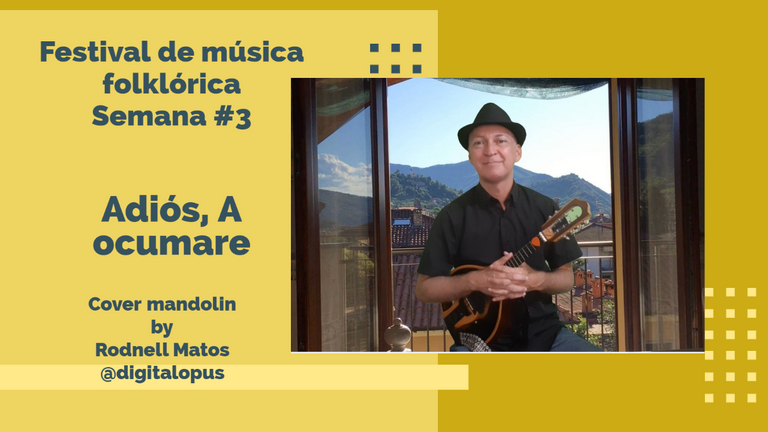
Un cordial saludo musical.
En esta oportunidad les traigo mi presentación para esta extraordinaria iniciativa de música folklorica, y aunque debo decir que en mi opinión me gusta más la palabra "tradicional" , aquí estoy con este bonito vals del cual les hago una pequeña historia de por qué se llama así...
El hermoso vals "Adiós, a Ocumare", fue compuesto en 1904 por don Ángel María Landaeta, secretario de justicia y primer violinista del estado. La banda en 1864, cuando Petare, la capital del estado de Miranda, se traslada a Okumare del Tuy.
Esta era la era del vals, y Venezuela estaba gobernada por el General Cipriano Castro, un gran bailarín de vals y patrón de los músicos de vals. La historia sigue al General Castro regresando a los 20 estados del estado federal de Zamora y con Thomas Lander (Ocumare, Yare y Quiripital), Paz Castillo (Santa Lucía y Santa Teresa) y Rafael Urdaneta (Cua y Charallave).
Ocumare del Tui fue designada capital de la provincia de Miranda. Esta actitud del gobierno causó indignación entre los vecinos de Petar, especialmente entre los funcionarios que se vieron obligados a abandonar sus casas y trasladarse a Thuy, sede de la nueva capital.
Ángel María Landeta estaba entre los funcionarios obligados a retirarse a Ocumare, así que compuso este hermoso vals que marcó la historia musical de Venezuela. Es precisamente por esta composición que se recordará a los músicos del siglo XX. Por cierto, la musa de Ánge María Landaeta, concibió el vals como un homenaje a la ciudad que tuvo que dejar (Petare), y expresó su despedida expresada en esta bella pieza instrumental. Maestro German U. Lira, Ángel María Landaeta (violín), Manuel Yelamo (flautista), Alejandro Gerentes (contrabajo), Juan Bautista (clarinete), Bernardino García, Tromba y los hermanos del virtuoso Lira, Domingo y Rafael (bombardino y flauta).
La canción, que se ha convertido en un clásico de la música venezolana en la actualidad, fue un éxito desde el primer momento, pero también contó con el apoyo político del gobierno.
Primero sirvió en el Estado Miranda y Ocumare del Tui, y en las fiestas y bailes que siempre disfrutaban ordenó incluirlos en su repertorio. Este vals fue popular desde un principio, pues fue copiado por todas las orquestas, y fue pieza fundamental en el repertorio de retiros y bailes, en los que asistía especialmente el General Castro. Sin embargo, hubo confusión desde el principio, ya que parecía separarse de Ocumare, no de Petare. En los créditos, "¡Adiós!" Se han reemplazado los signos de exclamación y las comas. Sin embargo, la tradición considera esta música como un símbolo de Ocumare del Tui, y sea cual sea el origen e intenciones de Landaeta, es percibida como tal por los habitantes de Ocumare del Tui, como cualquier pieza de música popular, para acabar Sobre todo, independientemente de su lealtad a Petare, estuvo y estará en el corazón de todos los tuyeros desde principios de 1900. Inicialmente, este vals no tenía letra, pero luego fue publicado por Arturo Barrios de Santa Lucía. A Gregorio José Timotes a veces se le atribuye la autoría de la letra.
Felicitaciones a la comunidad de VDC y al profesor @gaborockstar por esta iniciativa.

ENG:
Warm musical greetings.
On this occasion I bring you my presentation for this extraordinary folk music initiative, and although I must say that in my opinion I like the word "traditional" better, here I am with this beautiful waltz of which I will tell you a little story of why it is called So...
The beautiful waltz "Goodbye, to Ocumare" was composed in 1904 by Mr. Ángel María Landaeta, secretary of justice and first violinist of the state. The band in 1864, when Petare, the capital of the state of Miranda, was relocated to Ocumare del Tuy.
This was the era of waltz, and Venezuela was ruled by General Cipriano Castro, a great waltz dancer and patron of waltz musicians. The story follows General Castro returning to the 20 states of the federal state of Zamora with Thomas Lander (Ocumare, Yare, and Quiripital), Paz Castillo (Santa Lucía and Santa Teresa), and Rafael Urdaneta (Cua and Charallave).
Ocumare del Tuy was designated as the capital of the province of Miranda. This government action caused outrage among the residents of Petar, especially among officials who were forced to leave their homes and move to Thuy, the site of the new capital. Ángel María Landeta was among the officials forced to retire to Ocumare, so he composed this beautiful waltz that marked the musical history of Venezuela. It is precisely because of this composition that the musicians of the 20th century will be remembered. By the way, the muse of Ánge María Landaeta conceived the waltz as a tribute to the city she had to leave (Petare), and expressed her farewell through this beautiful instrumental piece. Master German U. Lira, Ángel María Landaeta (violin), Manuel Yelamo (flutist), Alejandro Gerentes (double bass), Juan Bautista (clarinet), Bernardino García, Tromba and the virtuoso Lira brothers, Domingo and Rafael (bombardino and flute).
The song, which has become a classic of Venezuelan music today, was a success from the very beginning, but it also had the political support of the government. It first served in the State of Miranda and Ocumare del Tui, and in the parties and dances they always enjoyed, it ordered them to be included in their repertoire. This waltz was popular from the beginning, as it was copied by all the orchestras, and was a fundamental piece in the repertoire of retreats and dances, which especially General Castro attended. However, there was confusion from the beginning, as it seemed to separate from Ocumare, not from Petare. In the credits, "Goodbye!" has replaced the exclamation marks and commas. However, tradition considers this music as a symbol of Ocumare del Tui, and whatever the origin and intentions of Landaeta, it is perceived as such by the residents of Ocumare del Tui, like any piece of popular music, to end above all, regardless of their loyalty to Petare, it was and will be in the heart of all the tuyeros since the early 1900s. Initially, this waltz had no lyrics, but it was later published by Arturo Barrios de Santa Lucía. Gregorio José Timotes is sometimes credited with the authorship of the lyrics.

Te invito a unirte a uno de los proyectos de apoyo para creadores de contenido audiovisual de la cadena de bloques HIVE más importantes en la actualidad; soportado por grandes desarrolladores promete ser el número uno entre las opciones de alojamiento de vídeos en español o inglés, puedes crear y compartir tus vídeos en esta gran comunidad.


▶️ 3Speak
The rewards earned on this comment will go directly to the people( @yusmi ) sharing the post on Twitter as long as they are registered with @poshtoken. Sign up at https://hiveposh.com.
Capaz puedes decirle adiós a Ocumare por un tiempo, pero no te despidas nunca de Hive... Vales lo que tocas jajaja. Excelente @digitalopus 💓
Que bonita pieza profesor nos ha regalado en esta semana #3 del festival, el sonido es verdaderamente bueno y la ejecución ni se diga... una verdadera pieza digna de nuestro acervo musical que merece ser escuchada cada vez más por nuestras nuevas generaciones. Saludos a toda la familia Manrrique desde Villa de Cura.
Siempre con nuestras tradiciones de primero. Gracias por sus palabras profe. Excelente iniciativa.
Congratulations @digitalopus! You have completed the following achievement on the Hive blockchain And have been rewarded with New badge(s)
Your next target is to reach 650 posts.
You can view your badges on your board and compare yourself to others in the Ranking
If you no longer want to receive notifications, reply to this comment with the word
STOPTo support your work, I also upvoted your post!
Check out our last posts:
Support the HiveBuzz project. Vote for our proposal!
Hola profe que bonita canción la que presenta en esta edición del festival, una vez creí haberla escuchado en su versión para cuatro solista y me encantó los arreglos. Felicitaciones por el gran sonido y la calidad del trabajo presentado. Gracias por compartir en #VDC community.
Hola estimada profesora. Es un placer poder mostrar siempre nuestra bella música venezolana. Gracias por apreciar mi presentación.
Que gran tema! Me recuerda mi niñez con la partitura al frente mientras mi mamá me escuchaba 🥺 eran momentos muy bonitos
Muy buena interpretación, me encantó!
Así es estimado, estas canciones son joyas musicales que hay que mantener vivas por siempre. Gracias por tu comentario.